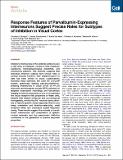| dc.contributor.author | Runyan, Caroline A. | |
| dc.contributor.author | Schummers, James | |
| dc.contributor.author | Van Wart, Audra | |
| dc.contributor.author | Kuhlman, Sandra J. | |
| dc.contributor.author | Wilson, Nathan R. | |
| dc.contributor.author | Huang, Z. Josh | |
| dc.contributor.author | Sur, Mriganka | |
| dc.date.accessioned | 2015-03-17T21:04:57Z | |
| dc.date.available | 2015-03-17T21:04:57Z | |
| dc.date.issued | 2010-09 | |
| dc.date.submitted | 2010-07 | |
| dc.identifier.issn | 08966273 | |
| dc.identifier.issn | 1097-4199 | |
| dc.identifier.uri | http://hdl.handle.net/1721.1/96068 | |
| dc.description.abstract | Inhibitory interneurons in the cerebral cortex include a vast array of subtypes, varying in their molecular signatures, electrophysiological properties, and connectivity patterns. This diversity suggests that individual inhibitory classes have unique roles in cortical circuits; however, their characterization to date has been limited to broad classifications including many subtypes. We used the Cre/LoxP system, specifically labeling parvalbumin(PV)-expressing interneurons in visual cortex of PV-Cre mice with red fluorescent protein (RFP), followed by targeted loose-patch recordings and two-photon imaging of calcium responses in vivo to characterize the visual receptive field properties of these cells. Despite their relative molecular and morphological homogeneity, we find that PV[superscript +] neurons have a diversity of feature-specific visual responses that include sharp orientation and direction-selectivity, small receptive fields, and band-pass spatial frequency tuning. These results suggest that subsets of parvalbumin interneurons are components of specific cortical networks and that perisomatic inhibition contributes to the generation of precise response properties. | en_US |
| dc.description.sponsorship | National Institutes of Health (U.S.) (Fellowship F31N067951) | en_US |
| dc.description.sponsorship | National Institutes of Health (U.S.) (Training Grant T32 MH074249) | en_US |
| dc.description.sponsorship | National Institutes of Health (U.S.) (Training Grant T32EY013935) | en_US |
| dc.description.sponsorship | National Institutes of Health (U.S.) (Fellowship F32EY018065) | en_US |
| dc.description.sponsorship | National Institutes of Health (U.S.) (Grant R01EY007023) | en_US |
| dc.description.sponsorship | National Institutes of Health (U.S.) (Grant R01EY018648) | en_US |
| dc.language.iso | en_US | |
| dc.publisher | Elsevier | en_US |
| dc.relation.isversionof | http://dx.doi.org/10.1016/j.neuron.2010.08.006 | en_US |
| dc.rights | Article is made available in accordance with the publisher's policy and may be subject to US copyright law. Please refer to the publisher's site for terms of use. | en_US |
| dc.source | Elsevier | en_US |
| dc.title | Response Features of Parvalbumin-Expressing Interneurons Suggest Precise Roles for Subtypes of Inhibition in Visual Cortex | en_US |
| dc.type | Article | en_US |
| dc.identifier.citation | Runyan, Caroline A., James Schummers, Audra Van Wart, Sandra J. Kuhlman, Nathan R. Wilson, Z. Josh Huang, and Mriganka Sur. “Response Features of Parvalbumin-Expressing Interneurons Suggest Precise Roles for Subtypes of Inhibition in Visual Cortex.” Neuron 67, no. 5 (September 9, 2010): 847–857. © 2010 Elsevier Inc | en_US |
| dc.contributor.department | Massachusetts Institute of Technology. Department of Brain and Cognitive Sciences | en_US |
| dc.contributor.department | Picower Institute for Learning and Memory | en_US |
| dc.contributor.mitauthor | Sur, Mriganka | en_US |
| dc.contributor.mitauthor | Runyan, Caroline A. | en_US |
| dc.contributor.mitauthor | Schummers, James | en_US |
| dc.contributor.mitauthor | Van Wart, Audra | en_US |
| dc.contributor.mitauthor | Wilson, Nathan R. | en_US |
| dc.relation.journal | Neuron | en_US |
| dc.eprint.version | Final published version | en_US |
| dc.type.uri | http://purl.org/eprint/type/JournalArticle | en_US |
| eprint.status | http://purl.org/eprint/status/PeerReviewed | en_US |
| dspace.orderedauthors | Runyan, Caroline A.; Schummers, James; Van Wart, Audra; Kuhlman, Sandra J.; Wilson, Nathan R.; Huang, Z. Josh; Sur, Mriganka | en_US |
| dc.identifier.orcid | https://orcid.org/0000-0002-6719-7085 | |
| dc.identifier.orcid | https://orcid.org/0000-0003-2442-5671 | |
| mit.license | PUBLISHER_POLICY | en_US |
| mit.metadata.status | Complete | |
